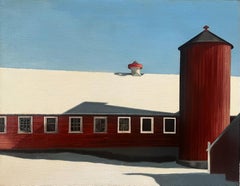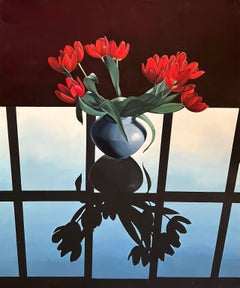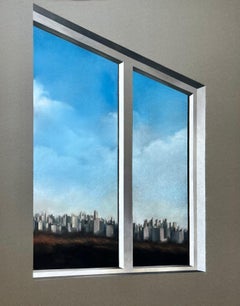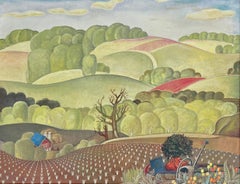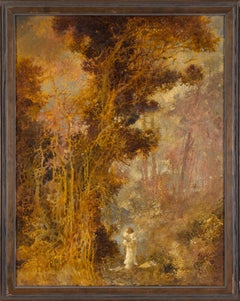Marina Stern Art
to
1
1
1
Overall Width
to
Overall Height
to
3
1
2
3
2
1
1
1
1
1
1
1
1
2
2
2
2
1
3
9,980
2,753
1,376
1,373
3
Artist: Marina Stern
Snowy Barn #2
By Marina Stern
Located in Los Angeles, CA
Snowy Barn #2, 1971, oil on canvas, signed and dated verso, 18 x 23 inches
Marina Stern was a multifaceted New York-based artist whose works ranged from Expressionism and Pop Art to the Neo Immaculate paintings and pastels for which she is best known. A native of Venice, Stern and her family fled in 1939 to escape Italy’s repressive racial laws. After living in England for several years, the family arrived in the United States in 1941. A bright and capable student, Stern graduated from New York’s Julia Richman High School at age 15 and soon enrolled in the Pratt Institute to pursue an interdisciplinary education in the arts. Despite majoring in advertising design, Stern favored her fine art courses. She graduated from Pratt in 1946 at age 18 and began working for advertising agencies.
After a brief marriage which ended in divorce, Stern married her second husband, who encouraged the artist to study at the Art Students League of New York, under the renowned Japanese American modernist, Yasuo Kuniyoshi. In Fall 1953, Stern gave birth to her first child, Michael, as she continued to study at the Arts Students League. Later in the Spring of 1957, Stern gave birth to her daughter Nina, as she continued to balance motherhood with her fine art practice and commercial art and design work.
Stern’s first significant exhibitions were in 1962 at the Waverly Gallery and the Osgood Gallery, both in New York, followed by inclusion of her work in the Bertha Schaefer Traveling Collage Show from 1963 to 1964. Stern made a splash in the avant-garde art world in 1964 when Time magazine reviewed a show at Amel Gallery which featured three of her audio-visual paintings. Time’s critic noted that Stern created the “cleverest noisemakers” in the exhibition. Time dubbed this work “Talkie Pop,” a label which Stern rejected. Following this recognition, Stern was selected for inclusion in The New American Realism at the Worcester Art Museum—a major showcase of leading artists, including Andy Warhol, Robert Indiana, Roy Lichtenstein, and Jasper Johns.
After the Worcester exhibition, Stern began to shift away from her “talking” Pop paintings to mysterious, interior scenes with orange, blue or black walls with windows or doors rising above black and white floors, often depopulated, but sometimes with figures. One of these works, Seven Minus Twenty-One Equals Seven, entered the permanent collection of New York’s Museum of Modern Art in 1966. By 1969, Stern began to incorporate industrial images into these scenes, and in the early 1970s, Stern created her first Neo-Immaculate works of rural, and urban landscapes, which she described as her most satisfying work. Stern often depicted locations that she held close -- New York, New Jersey, Iowa (where her son attended college), Sharon, Connecticut (where her family spent weekends and vacations) and her native Venice, Italy.
Stern’s success as a Neo Immaculate painter led to consistent New York gallery representation for over two decades, first with Lee Ault & Co and James Yu Gallery, and then Forum Gallery, where she had six solo shows. In 1971, Stern completed a Neo-Immaculate mural commission for the Port Authority of New York, George Washington Bridge #1 and #2, followed by another commission from the NY Cityarts Public Art Program in 1976 for a mural on Mulberry Street. Stern also enjoyed solo exhibitions in Boston (Eleanor Rigelhaupt Gallery), Connecticut (Silo Gallery, the Hotchkiss School, J. Rosenthal Fine Arts Gallery, Tremaine Gallery, and Staib Gallery), Chicago (Michael Rosenfeld Gallery), and Santa Fe (Santa Fe East Gallery). Her work was included in group shows at over a dozen public institutions, including The National Academy of Design, The Staten Island Museum, Worcester Art Museum, the Oklahoma Art Center, and the Arkansas Art Center. The Southern Alleghenies Museum of Art hosted a retrospective of four decades of Stern’s work from January 19 to April 22, 2007, entitled Perception and the Cultural Environment: The Paintings of Marina...
Category
1970s American Modern Marina Stern Art
Materials
Canvas, Oil
Red Tulips
By Marina Stern
Located in Los Angeles, CA
Red Tulips, 1987, oil on canvas, signed and dated verso, 40 x 34 inches, exhibited: Marina Stern Venice – New Works, Forum Gallery, New York, N.Y., from March 4 to April 1, 1989 (label verso)
Marina Stern was a multifaceted New York-based artist whose works ranged from Expressionism and Pop Art to the Neo Immaculate paintings and pastels for which she is best known. A native of Venice, Stern and her family fled in 1939 to escape Italy’s repressive racial laws. After living in England for several years, the family arrived in the United States in 1941. A bright and capable student, Stern graduated from New York’s Julia Richman High School at age 15 and soon enrolled in the Pratt Institute to pursue an interdisciplinary education in the arts. Despite majoring in advertising design, Stern favored her fine art courses. She graduated from Pratt in 1946 at age 18 and began working for advertising agencies.
After a brief marriage which ended in divorce, Stern married her second husband, who encouraged the artist to study at the Art Students League of New York, under the renowned Japanese American modernist, Yasuo Kuniyoshi. In Fall 1953, Stern gave birth to her first child, Michael, as she continued to study at the Arts Students League. Later in the Spring of 1957, Stern gave birth to her daughter Nina, as she continued to balance motherhood with her fine art practice and commercial art and design work.
Stern’s first significant exhibitions were in 1962 at the Waverly Gallery and the Osgood Gallery, both in New York, followed by inclusion of her work in the Bertha Schaefer Traveling Collage Show from 1963 to 1964. Stern made a splash in the avant-garde art world in 1964 when Time magazine reviewed a show at Amel Gallery which featured three of her audio-visual paintings. Time’s critic noted that Stern created the “cleverest noisemakers” in the exhibition. Time dubbed this work “Talkie Pop,” a label which Stern rejected. Following this recognition, Stern was selected for inclusion in The New American Realism at the Worcester Art Museum—a major showcase of leading artists, including Andy Warhol, Robert Indiana, Roy Lichtenstein, and Jasper Johns.
After the Worcester exhibition, Stern began to shift away from her “talking” Pop paintings to mysterious, interior scenes with orange, blue or black walls with windows or doors rising above black and white floors, often depopulated, but sometimes with figures. One of these works, Seven Minus Twenty-One Equals Seven, entered the permanent collection of New York’s Museum of Modern Art in 1966. By 1969, Stern began to incorporate industrial images into these scenes, and in the early 1970s, Stern created her first Neo-Immaculate works of rural, and urban landscapes, which she described as her most satisfying work. Stern often depicted locations that she held close -- New York, New Jersey, Iowa (where her son attended college), Sharon, Connecticut (where her family spent weekends and vacations) and her native Venice, Italy.
Stern’s success as a Neo Immaculate painter led to consistent New York gallery representation for over two decades, first with Lee Ault & Co and James Yu Gallery, and then Forum Gallery, where she had six solo shows. In 1971, Stern completed a Neo-Immaculate mural commission for the Port Authority of New York, George Washington Bridge #1 and #2, followed by another commission from the NY Cityarts Public Art Program in 1976 for a mural on Mulberry Street. Stern also enjoyed solo exhibitions in Boston (Eleanor Rigelhaupt Gallery), Connecticut (Silo Gallery, the Hotchkiss School, J. Rosenthal Fine Arts Gallery, Tremaine Gallery, and Staib Gallery), Chicago (Michael Rosenfeld Gallery), and Santa Fe (Santa Fe East Gallery). Her work was included in group shows at over a dozen public institutions, including The National Academy of Design, The Staten Island Museum, Worcester Art Museum, the Oklahoma Art Center, and the Arkansas Art Center. The Southern Alleghenies Museum of Art hosted a retrospective of four decades of Stern’s work from January 19 to April 22, 2007, entitled Perception and the Cultural Environment: The Paintings of Marina...
Category
1980s American Modern Marina Stern Art
Materials
Canvas, Oil
$12,000
New York Window
By Marina Stern
Located in Los Angeles, CA
New York Window, 1986, mixed media on illustration board, signed and dated lower right, 31 x 20 inches (image), 36 ½ x 28 inches (sheet)
Marina Stern was a multifaceted New York-based artist whose works ranged from Expressionism and Pop Art to the Neo Immaculate paintings and pastels for which she is best known. A native of Venice, Stern and her family fled in 1939 to escape Italy’s repressive racial laws. After living in England for several years, the family arrived in the United States in 1941. A bright and capable student, Stern graduated from New York’s Julia Richman High School at age 15 and soon enrolled in the Pratt Institute to pursue an interdisciplinary education in the arts. Despite majoring in advertising design, Stern favored her fine art courses. She graduated from Pratt in 1946 at age 18 and began working for advertising agencies.
After a brief marriage which ended in divorce, Stern married her second husband, who encouraged the artist to study at the Art Students League of New York, under the renowned Japanese American modernist, Yasuo Kuniyoshi. In Fall 1953, Stern gave birth to her first child, Michael, as she continued to study at the Arts Students League. Later in the Spring of 1957, Stern gave birth to her daughter Nina, as she continued to balance motherhood with her fine art practice and commercial art and design work.
Stern’s first significant exhibitions were in 1962 at the Waverly Gallery and the Osgood Gallery, both in New York, followed by inclusion of her work in the Bertha Schaefer Traveling Collage Show from 1963 to 1964. Stern made a splash in the avant-garde art world in 1964 when Time magazine reviewed a show at Amel Gallery which featured three of her audio-visual paintings. Time’s critic noted that Stern created the “cleverest noisemakers” in the exhibition. Time dubbed this work “Talkie Pop,” a label which Stern rejected. Following this recognition, Stern was selected for inclusion in The New American Realism at the Worcester Art Museum—a major showcase of leading artists, including Andy Warhol, Robert Indiana, Roy Lichtenstein, and Jasper Johns.
After the Worcester exhibition, Stern began to shift away from her “talking” Pop paintings to mysterious, interior scenes with orange, blue or black walls with windows or doors rising above black and white floors, often depopulated, but sometimes with figures. One of these works, Seven Minus Twenty-One Equals Seven, entered the permanent collection of New York’s Museum of Modern Art in 1966. By 1969, Stern began to incorporate industrial images into these scenes, and in the early 1970s, Stern created her first Neo-Immaculate works of rural, and urban landscapes, which she described as her most satisfying work. Stern often depicted locations that she held close -- New York, New Jersey, Iowa (where her son attended college), Sharon, Connecticut (where her family spent weekends and vacations) and her native Venice, Italy.
Stern’s success as a Neo Immaculate painter led to consistent New York gallery representation for over two decades, first with Lee Ault & Co and James Yu Gallery, and then Forum Gallery, where she had six solo shows. In 1971, Stern completed a Neo-Immaculate mural commission for the Port Authority of New York, George Washington Bridge #1 and #2, followed by another commission from the NY Cityarts Public Art Program in 1976 for a mural on Mulberry Street. Stern also enjoyed solo exhibitions in Boston (Eleanor Rigelhaupt Gallery), Connecticut (Silo Gallery, the Hotchkiss School, J. Rosenthal Fine Arts Gallery, Tremaine Gallery, and Staib Gallery), Chicago (Michael Rosenfeld Gallery), and Santa Fe (Santa Fe East Gallery). Her work was included in group shows at over a dozen public institutions, including The National Academy of Design, The Staten Island Museum, Worcester Art Museum, the Oklahoma Art Center, and the Arkansas Art Center. The Southern Alleghenies Museum of Art hosted a retrospective of four decades of Stern’s work from January 19 to April 22, 2007, entitled Perception and the Cultural Environment: The Paintings of Marina...
Category
1980s American Modern Marina Stern Art
Materials
Oil Pastel, Pastel, Illustration Board, ABS
Related Items
WPA Landscape American Scene Social Realism Mid 20th Century Modern Farm Rural
By James McCracken
Located in New York, NY
WPA Landscape American Scene Social Realism Mid 20th Century Modern Farm Rural
James McCracken (1875 – 1967)
WPA Landscape
28 x 36 inches
Oil on canvas, c. 1930s
Signed lower right
...
Category
1930s American Modern Marina Stern Art
Materials
Canvas, Oil
Woman and Child in the Woods - Midcentury Abstracted Landscape in Oil on Canvas
Located in Soquel, CA
Woman and Child in the Woods - Midcentury Abstracted Landscape in Oil on Canvas
Dramatic abstracted painting of a woman holding a child in the woods by Maley (20th Century). This pi...
Category
1970s American Modern Marina Stern Art
Materials
Canvas, Oil, Stretcher Bars
$2,500
H 26.5 in W 21 in D 1 in
Farm in the Valley - Plein Air California Landscape
Located in Soquel, CA
Farm in the Valley - Plein Air California Landscape
Beautiful mid century landscape of a California farm by Baumgardner (American, 20th Century). The viewer stands on a dirt road, w...
Category
20th Century American Modern Marina Stern Art
Materials
Canvas, Oil
"Still Life with Flowers" American Modern Colorful Oil Painting on Canvas 1936
By Ben Benn
Located in New York, NY
A strong modernist oil painting depicted in 1936 by Russian-American painter Ben Benn. With a highly recognizable modern style, fast brush stroke and expressive use of color, shape, ...
Category
1930s American Modern Marina Stern Art
Materials
Oil, Canvas
$2,700 Sale Price
40% Off
H 26 in W 21 in D 0.75 in
1940s Still Life of Squash by Notable Chicago Modernist Artist Flora Schofield
Located in Chicago, IL
A large and wonderful Modernist still life of a cast iron pot, squash and ladle by notable Chicago artist Flora Schofield. Artwork size: 28 1/2" x 20". Framed size: 24" x 26". Signed Schofield lower left.
A painter, print maker and sculptor, Flora Schofield (Schoenfield), was born in Lanark, Illinois. She studied at the School of the Art Institute of Chicago and taught Saturday classes there until 1904. Schoenfield also studied with Charles Hawthorne, B.J.O Nordfeldt and William Zorach in Provincetown, Massachusetts. She studied with Albert Gleizes, Fernand Leger and Natalia Goncharova in Paris, France.
In 1923, Schofield’s abstractions caused a split at the venerable Chicago Society of Artists. When her artwork was was accepted by the jury, the notable Impressionist painter Pauline Palmer and the notable Modernist painter Carl Hoeckner got into a row that ended-up splitting the group. The Impressionists then broke away into their own organization called the ”Association of Chicago Painters and Sculptors”.
Paintings by Flora Schofield have been exhibited at the Pennsylvania Academy of the Fine Arts, Philadelphia; the Salon d’Automne and Salon de Independants, Paris; the Salons of America; the Society of Independent Artists, New York; the Wichita Museum of Art, Wichita; Gallery Carmine, Paris; the National Arts Club Galleries, New York; Marshall Fields Galleries...
Category
1940s American Modern Marina Stern Art
Materials
Canvas, Oil
$3,500 Sale Price
27% Off
H 34 in W 26 in
Missouri American Modernist famous in Europe - abstracted mid century Venice
Located in Norwich, GB
Meet the genuinely exciting modernist William Einstein, who is probably better known in Europe, where numerous publications on his work have been written, than in his native US!
Eins...
Category
1950s American Modern Marina Stern Art
Materials
Canvas, Oil
$1,300
H 24.41 in W 15.75 in
Original Oil Painting Big Sur, Monterey California Landscape
By Virginia Shackles
Located in Soquel, CA
A beautiful American Impressionist oil seascape of the rugged Big Sur coast, Carmel California by Virginia Shackles (American, 1921-2020). The composition is pleasing with an interes...
Category
Mid-20th Century American Modern Marina Stern Art
Materials
Canvas, Oil
$1,550
H 24 in W 30 in D 1 in
Modern American Still Life Oil Painting Flowers Pitcher Mid Century Female
Located in Buffalo, NY
A mid-century modern oil painting by listed female artist Helen L. Roberts.
This painting depicts an interior scene with a vase of beautiful flowers and decorative pitcher.
Housed ...
Category
1950s American Modern Marina Stern Art
Materials
Canvas, Oil
$920 Sale Price
20% Off
H 16 in W 22 in
Mid Century Naturaleza Muerta Con Mangoes (Still Life w. Mangoes) by Dosamantes
By Francisco Dosamantes
Located in Soquel, CA
Mid Century Naturaleza Muerta Con Mangoes (Still Life w. Mangoes) by Francisco Dosamantes
Substantial and brilliant modernist still-life painting mangoes by Francisco Dosamantes (Mexico, 1911-1986) Exhibition label on verso (circa 1957), "Salon De Plasticas Mexicana - Instituto Nacional De Bellas Artes - Francisco Dosamantes, Naturaleza Muerta Con Mangoes." Image 24"H x 31.5"W.
"Francisco Dosamantes was born in Mexico City on October 4, 1911. His father was Daniel Dosamantes who was a builder, interior decorator and painter. Since its founding in 1949, the Hall of Plastic Mexican SPM, has accommodated the most representative work of the national art. Throughout its existence they have been part of hundreds of painters, sculptors, engravers, designers, ceramists and photographers of all tendencies and generations. Jut names: Diego Rivera, David Alfaro Siqueiros, Gerardo Murillo "Dr. Atl" Frida Kahlo, Rufino Tamayo, Francisco Dosamantes, Jorge González Camarena, Leopoldo Mendez...
Category
1950s American Modern Marina Stern Art
Materials
Canvas, Oil
$12,000 Sale Price
20% Off
H 37 in W 34 in D 3 in
"Cattleya Orchids" Jane Peterson, Modernist Bright Flowers, Female Impressionist
By Jane Peterson
Located in New York, NY
Jane Peterson
Cattleya Orchids, circa 1940s
Signed lower right
Oil on canvas
32 x 32 inches
Provenance
Estate of the artist
Artist’s estate sale, Ipswich, Massachusetts, 1960s
Priva...
Category
1930s American Modern Marina Stern Art
Materials
Canvas, Oil
John Edward Thompson “Early Spring (Thompson’s Studio)” 1933 Colorado Modernist
By John Edward Thompson
Located in Denver, CO
Early Spring (Thompson’s Studio) is an original 1933 oil on canvas painting by celebrated Colorado modernist John Edward Thompson (1882–1945). This striking Impressionist work offers...
Category
1930s American Modern Marina Stern Art
Materials
Canvas, Oil
$2,850
H 26.25 in W 21 in D 2 in
Still Life of Fruit on Table Style of Paul Cézanne
Located in Soquel, CA
Modern Cézanne style still life with collage by Dorothy Jane (Milne) Eggen (American, 1907-1986) Her still life is a Homage to Paul Cézanne's ...
Category
1960s American Modern Marina Stern Art
Materials
Canvas, Oil, Illustration Board, Newsprint
$2,120 Sale Price
20% Off
H 22.75 in W 26.5 in D 0.75 in
Marina Stern art for sale on 1stDibs.
Find a wide variety of authentic Marina Stern art available for sale on 1stDibs. Customers who are interested in this artist might also find the work of Mitchell Funk, Elizabeth Murray, and Porfirio Salinas.
